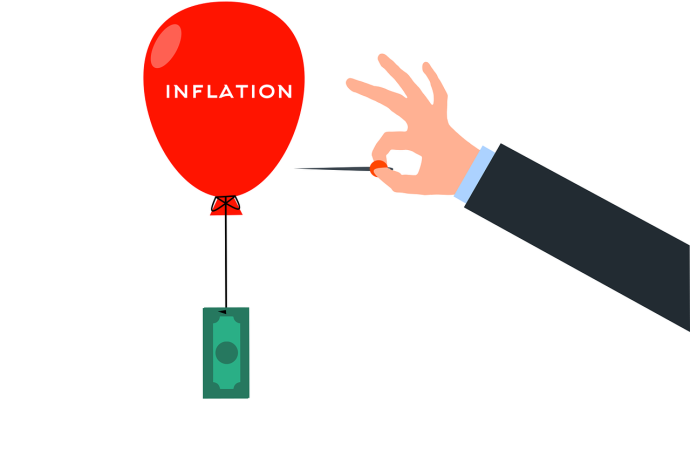As financial markets have been showing their panicky side in the last few weeks, we’ve been hearing various accounts of what’s driving the volatility. One of the key narratives goes something like this: 1) wages are moving up in the United States, and 2) inflation is starting to increase, which could well 3) produce a spike in inflation as was seen in the 1970s, which means it’s likely that 4) central banks will have to raise interest rates more quickly, potentially slowing the economy; ergo: 5) the sky is falling!
Although there are some reasons to be anxious (particularly if you’ve been betting on low stock market volatility or are having a hard time making your mortgage payments), the underlying narrative about the inevitability of a return to high inflation levels is highly suspect.
So, before we all start stocking up on gold and canned goods, let’s take a more careful look at each piece of this logic.
Yes — wages are finally starting to move up in the US, after almost a decade of stagnation. In January, US wages rose at a faster rate than they have since the recession, while the Federal Reserve predicts that inflation will continue to move up this year towards their goal. This is welcome news, given that the long recovery from the 2008 global financial crisis has not translated until now into reasonable wage gains.
In Canada, the story is more complicated: unemployment is lower than it has been since 1976, and inflation is moving slowly upwards towards the Bank of Canada’s 2% target, but wage pressures remain modest.
Yet, while the first two parts of the inflation narrative hold true, at least in the US, the next leap of logic, which warns of a sudden takeoff in inflation like that seen in the 1970s, is far less persuasive.
For those who are either too young to remember this decade (or aren’t quite as fascinated as I am by this period in economic history) it’s worth explaining that the 1970s are a bogeyman for investors and central bankers. Between 1971 and 1980, the post-war monetary order of fixed exchange rates was dismantled, the US dollar was delinked from gold, there were two OPEC oil crises that more than quadrupled the price of oil, and inflation rates got close to 15% in the US and Canada, and topped 25% in the UK.
At the end of this decade-long crisis, the central bankers decided to give monetarism a go — trying to slow the expansion of the money supply and raising interest rates dramatically. In the US, Federal Reserve Chairman Paul Volcker pushed the bank’s target rate close to 20%, while in Canada, mortgage rates went as high as 21%. Although the monetarist experiment ultimately failed, these massive interest rate increases did eventually squeeze inflation out of the economies, largely through painful recessions.
Although there is still a great deal of debate about what caused and ultimately solved the 1970s’ “Great Inflation,” this traumatic experience paved the way to the current “new monetary consensus” in inflation-management policy, with its unwavering faith in central bank independence and very low inflation targets. Now, any sign that low inflationary expectations are becoming unanchored (i.e., people are receiving more reasonable wage increases) can produce panic.
Of course, no one wants to go back to the 1970s (and not only because of the dodgy haircuts, disco, and bell-bottoms). But how real is the risk that we might end up repeating history?
There several good reasons why we should be skeptical of such leaps in logic.
For one thing, inflation not only depends on people’s expectations of where prices are headed, it also depends on their ability to act on these expectations — by, for example, demanding wage increases. In the 1970s, workers had considerable power to make those demands, with roughly twice as many unionized in the UK and the US than today. As the recent recovery from the 2008 crisis has made very clear, employers now have far more power in determining wages than workers.
It is also worth remembering that the 1970s experience of high inflation was linked to a series of massive shocks — most notably the OPEC crises.
If we aren’t likely to see a return to the inflationary spikes of the 1970s, then what should we be looking for central bankers to do today? Should they double down on inflation targets as many hawks have suggested and move aggressively to pre-empt any jumps in inflation?
The short answer is no.
Just because inflation is finally moving towards the target after nearly a decade of trying to get it there doesn’t mean that inflation targets actually make sense — particularly the extremely low targets that have recently become the orthodoxy.
As I have argued in a Foreign Affairs article, making very low interest rates the only goal of monetary policy has considerable political costs — costs that become very apparent when even the most modest of wage increases for hard-working families becomes a sign that we need another round of monetary austerity.
Yet that doesn’t mean that we are quite out of the economic woods.
Although inflation isn’t likely to skyrocket, even a modest increase will tend to lead to higher interest rates, which will reduce the easy credit that has been making stock markets so bubbly of late. Since stock markets are prone to panics as well as manias, it’s likely to be a rough ride for some time.
A modest rise in interest rates will still pose some very real risks for those economies, like Canada’s, with significant household debt.
With interest rates still extremely low and government debt levels already high, we have fewer tools for coping with the next major bump in the economic road.
And, of course, Donald Trump is still the president of the United States, which means the future of the global economy is extremely uncertain.
So, feel free to panic — just not about inflation.










